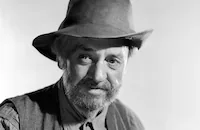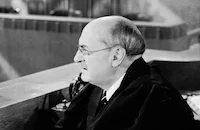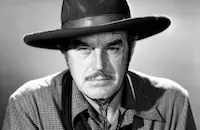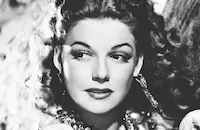The Plainsman

Brief Synopsis
Cast & Crew
Cecil B. Demille
Gary Cooper
Jean Arthur
James Ellison
Charles Bickford
Helen Burgess
Film Details
Technical Specs

Synopsis
At the close of the Civil War, President Abraham Lincoln is assassinated in the East while General George Custer fights the Indians in the West. As John Lattimer arrives in Leavenworth, Missouri, to sell seven-shot rifles to the Indians, Buffalo Bill Cody and his new wife Louisa are reunited with Wild Bill Hickok and Calamity Jane. Following the massacre of half the garrison at Fort Piney by thousands of Sioux Indians, General Custer orders Cody to take ammunition to the fort, while Hickok goes after their chief, Yellow Hand. As Louisa confesses her pregnancy to Jane, Cheyenne Indians attack the Cody home and Jane is taken to the Cheyenne camp, where the Indians threaten to kill Hickok unless she tells them Cody's whereabouts. Jane, in love with Hickok, saves his life, but sacrifices Cody's men, who are ambushed by Cheyenne using Lattimer's rifles. As Hickok makes his way to the front, he sends Jane to alert Custer. Cody and Hickok, along with what is left of the men at Fort Piney, defend themselves against the Indians. As the fort's bugler dies, Custer's bugle is heard in the distance and the Indians retreat. Back in town, Hickok challenges John Lattimer to a draw, but is forced to kill three of Lattimer's men, former soldiers, instead. After Hickok follows Lattimer into the Black Hills, Custer orders Cody to bring him Hickok dead or alive for murdering soldiers. Weeks later, as Cody tracks Hickok, a lone Cheyenne Indian, carrying the U.S. 7th Cavalry's flag, tells of Custer's defeat. Meanwhile, Yellow Hand and Sitting Bull plot to extinguish the white man using Lattimer's rifles as Hickok and Cody meet in Deadwood to the stop Lattimer's shipment. There Hickok shoots Lattimer dead in self-defense and rounds up his co-conspirators in the Bella Union saloon, where they play poker. As Hickok plays his hand of black aces and eights, Jack McCall, who had earlier warned Lattimer about Hickok, shoots him in the back, killing him. McCall is then arrested by Merritt and Cody's troopers, and Merritt exonerates Cody. Calamity kisses Cody, saying, "That's one kiss you won't wipe off." Hickok and Custer and his troops later ride off to battle.

Director

Cecil B. Demille
Cast

Gary Cooper

Jean Arthur

James Ellison

Charles Bickford
Helen Burgess

Porter Hall

Paul Harvey
Victor Varconi

John Miljan
Frank Mcglynn Sr.

Granville Bates

Frank Albertson
Purnell Pratt
Fred Kohler
Pat Moriarty

Charles Judels

Harry Woods

Anthony Quinn
Francis Mcdonald
George Ernest
George Macquarrie

George Hayes

Fuzzy Knight
Irene Bennett
Louise Stuart

Gail Sheridan
George Sparks
Curtis Nero
Billy Mcclain
Arthur Singley

Bud Flanagan
Ralph Malone
E. W. Borman
Walter Mcgrail
Wilbur Mack

Max Davidson
Buck Connors
Oscar Rudolph
Philo Mccullough
Jack Clifford
Frank Layton
Noble Johnson
Sonny Chorre
Richard Robles
Greg Whitespear
Chief Thundercloud
Clay Deroy
Wesley Giraud
Chuck Hamilton
Hank Bell
Lane Chandler
Myron Geiger

Bob Burns
Duke Lee
Jack Walters
Frank Watson
Kenneth Gibson
Ben F. Hendricks
James Baker
Kenny Cooper
Cecil Kellogg
Whitey Severn
Ervey Collins
Frank Cordell
John Eckert
Lloyd Saunders
Al Burk
Slim Hightower
Jimmy Phillips
Captain William H. Royal
Ted Oliver
Richard Alexander
David Clyde
Hooper Atchley
Robert Wilber
Bud Osborne
Francis Sayles
Franklyn Farnum
Don Rowan
Earl Askam
Stanley Andrews
Sherwood Bailey
Edgar Deering
Edwin Maxwell
Bruce Warren
Mark Strong
P. E. "tiny" Newland
Sidney D'albrook
Ed Schaefer
Bob Ellsworth
Nelson Mcdowell
Marty Joyce
Blackjack Ward
Jess Caven
Jane Keckley
Cora Shumway
Everett Brown
Louis Natheaux
Colin Chase
Jack Fife
Bud Fine
Blue Washington
Crew
Roland Anderson
George Antheil
Anne Bauchens
Al Burk
Cecil B. Demille
Cecil B. Demille
Joe Deyong
Hans Dreier
John Eckert
Farciot Edouart
Dwight Franklin
A. E. Freudeman
Richard Harlan
Slim Hightower
Gordon Jennings
Grover Jones
Harold Lamb
William Lebaron
Harry Lindgren
Jeanie Macpherson
Edwin Maxwell
Louis Mesenkop
Victor Milner
Boris Morros
Jimmy Phillips
Lynn Riggs
George Robinson
Arthur Rosson
Lloyd Sanders
Visart
Dewey Wrigley
Waldemar Young
Adolph Zukor

Videos
Movie Clip





Film Details
Technical Specs

Articles
The Plainsman (1936) - THE PLAINSMAN
With its grandly entertaining mix of patriotic sentiment, aw-shucks romance and rousing battle scenes, the Western epic, The Plainsman (1937), bears producer/director Cecil B. DeMille's signature as clearly as Rio Bravo (1959) belongs to Howard Hawks and The Searchers (1956) to John Ford. DeMille's association with the Western genre dates back to his debut feature, The Squaw Man (1914), which he remade in 1918 and 1931. Other DeMille Westerns include Rose of the Rancho (1914), A Romance of the Redwoods (1917), Union Pacific (1939), and North West Mounted Police (1940), set in Canada. While few would place DeMille in Hawks' and Ford's lofty company, during his career of some 50 years he displayed a consistent knack for turning a profit and made a number of very fine films along the way. The Cheat (1915), for instance, is considered a groundbreaking work in the development of film editing.
DeMille's impressive production for The Plainsman boasts, among other things, a three-acre set for Deadwood City and a recreation of the battle of Little Big Horn which was filmed on location in the Cheyenne Indian Reservation at Lame Deer, Montana, employing some two thousand Native Americans as extras. In order to maintain control over the second unit shoot, DeMille kept a model of the second unit location along with detailed plans for shot setups, which he conveyed to second unit director Art Rosson over the telephone.
One of the key assets of The Plainsman, however, is its cast. The reviewer in The Motion Picture Herald wrote that the film was "[p]layed with spirit and intelligent understanding by principals and entire supporting cast, with class individual performances sticking out all over [...]" Gary Cooper, who plays Wild Bill Hickok, became one of DeMille's favorite leading men, appearing subsequently in North West Mounted Police, The Story of Dr. Wassell (1944) and Unconquered (1947). Frank S. Nugent of the New York Times noted that Jean Arthur bears only a passing resemblance to the traditional image of Calamity Jane: "She doesn't chaw tobacco any more. She doesn't cuss. She doesn't run around with the boys. She just talks low and husky, is cute when she is being tomboyish, and she loves Wild Bill so much she almost faints when the Indians start torturing him to make him tell which way the ammunition convoy is heading." For her role Jean Arthur did, however, learn to use a bullwhip, which she handles impressively. Look for a young Anthony Quinn as the lone Cheyenne who tells Cody and Hickok of Custer's defeat at Little Bighorn. Quinn, incidentally, later married DeMille's daughter Katherine.
DeMille may have taken clear liberties with the story but the Paramount executives, he claims, wanted even more. DeMille recalls in his 1959 autobiography: "As every historian of the Old West knows, Jack McCall killed Wild Bill Hickok by shooting him in the back. It was worrisome enough to the Paramount executives that we were making a picture in which the hero, Gary Cooper at that, was to be killed in the last reel instead of riding off into the sunset with Jean Arthur in the happy ending which audiences are always expected to demand. First the executives asked me not to kill Wild Bill; I told them I could not remake history to that extent. 'Well then,' Adolf Zukor said finally, 'if he has to be killed, don't let him be killed by that little rat, McCall. At least let Charles Bickford kill him!'" Fortunately, DeMille stood firm. While accuracy was obviously never DeMille's strong point--just compare the episode of the golden calf in The Ten Commandments (1956) with the corresponding passage in the Old Testament--his storytelling instincts were formidable and the scene of Hickok's death remains effective to this day.
Producer and Director: Cecil B. DeMille.
Screenplay: Waldemar Young, Harold Lamb and Lynn Riggs, inspired by stories by Courtney Ryley Cooper and Frank J. Wilstach's book Wild Bill Hickok, the Prince of Pistoleers (1926).
Photography: Victor Milner and George Robinson.
Art Direction: Hans Dreier and Roland Anderson.
Editor: Anne Bauchens.
Music: George Antheil.
Principal cast: Gary Cooper (Wild Bill Hickok), Jean Arthur (Calamity Jane), James Ellison (Buffalo Bill Cody), Charles Bickford (John Lattimer), Helen Burgess (Louisa Cody), Porter Hall (Jack McCall), Paul Harvey (Yellow Hand), Victor Varconi (Painted Horse), John Miljan (General George A. Custer), Frank McGlynn, Sr. (Abraham Lincoln).
BW-113m. Closed captioning.
By James Steffen

The Plainsman (1936) - THE PLAINSMAN
Quotes
Trivia
The cavalry sequences were shot with members of the Wyoming National Guard. Two guardsmen were badly hurt during filming of a charge scene.
2,000 Indian actors were used as extras for the Custer massacre sequence.
Paramount executives wanted Wild Bill Hickok to survive the card-game shootout, but director DeMille resisted and got his way.
Anthony Quinn told Cecil B. DeMille that he spoke fluent Cheyenne. Quinn's description of the Custer Battle is gibberish, but DeMille was impressed.
Notes
The ending of the film following the poker game was missing from the viewed print. The conclusion of the plot summary was taken from the release dialogue script found in the Paramount Script Collection at the AMPAS Library. The film's opening narration states, "Among the men who thrust forward America's frontier were Wild Bill Hickok and Buffalo Bill Cody. The story that follows compresses many years, many lives, and widely separated events into one narrative-in an attempt to do justice to the courage of the plainsman of the West." The closing narration states: "It shall be as it was in the past.../Not with dreams,/but with strength and with courage/Shall a nation be molded to last." Wild Bill Hickok's well-deserved reputation as a gunfighter was established in an interview with Colonel George Ward Nichols published in Harper's New Monthly Magazine in 1867. Hickok was a good shot and probably killed at least seven men. He was a scout in the Union Army during the Civil War and after the war, he became a marshal in Hays City, KS, and then in Abilene, KS. He appeared in a play with Buffalo Bill Cody in 1873, and in 1876, Hickok was shot in the back by Jack McCall during a poker game in Deadwood, Dakota Territory. For more biographical information about Buffalo Bill Cody, please see then entry above for Buffalo Bill, and for additional information on General George Armstrong Custer, please consult the entry below for They Died With Their Boots On.
As reported in Daily Variety and Hollywood Reporter, shooting on a three-acre set of Deadwood City in 1865 built by Paramount began on July 21, 1936. While DeMille directed interiors, he gave instructions to second unit director Arthur Rosson, who was on location, via telephone. DeMille had with him a ten-foot model of Rosson's location scenes, as well as charts marked with every camera set-up. The cavalry sequences were shot with the Wyoming National Guard at Pole Mountain, Wyoming, twenty-one miles east of Laramie. On July 17, 1936, Hollywood Reporter reported that two guardsmen has been badly hurt the previous day while Rosson was shooting a charge scene. The scene of Custer's massacre was shot on the Cheyenne Indian Reservation at Lame Deer, Montana, where two thousand Indian actors were used as extras. Additional scenes were also shot in Birney, Montana. While location work continued in Montana, one production unit went on location at the Paramount ranch outside Los Angeles on July 24, 1936. According to a Hollywood Reporter news item on July 16, 1936, DeMille engaged actor Edwin Maxwell to serve temporarily as dialogue director. According to modern sources, Paramount studio executives wanted "Wild Bill" to survive the card game shoot-out at the end of the film, but DeMille resisted. Modern sources list the following character names: Edgar Dearing (A courier from Custer), Edwin Maxwell (Stanton, Secretary of War) and Bruce Warren (Purser of the "Lizzie Gill"). Modern sources also add the following names to the cast: Francis Ford, Irving Bacon, John Hyams, Charles Stevens, Arthur Aylesworth, Douglas Wood, George Cleveland, Lona Andre, Leila McIntyre, Harry Stubbs, Davison Clark, Charles W. Hertzinger, William Humphries, Sidney Jarvis, Wadsworth Harris, Tex Driscoll, and Stanhope Wheatcroft.

Miscellaneous Notes
Released in United States 1937
Released in USA on video.
Released in United States 1937













